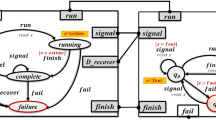Abstract
This paper presents a formal behavioural specification framework for specifying and verifying the correct behaviour of distributed Fractal components. The first contribution is a parameterised and hierarchical behavioural model called pNets that serves as a low-level semantic framework for expressing the behaviour of various classes of distributed languages and as a common internal format for our tools. Then, we use this model to define the generation of behavioural models for applications ranging from sequential Fractal components, to distributed objects, and finally to distributed components. Our models are able to characterise both functional and non-functional behaviours and the interaction between the two concerns. Finally, this work has resulted in the development of tools allowing the non-expert programmer to specify the behaviour of his components and (semi)automatically verify properties of his application.














Similar content being viewed by others
Notes
Cleaveland and Riely [25] was using a slightly relaxed condition called “galois insertions”.
References
Bruneton E, Coupaye T, Leclercp M, Quema V, Stefani J (2004) An open component model and its support in java. In: 7th int symp on component-based software engineering (CBSE-7), LNCS, vol 3054. Springer
CoreGRID, Programming Model Institute (2006) Basic features of the grid component model (assessed). Technical report, Deliverable D.PM.04. http://www.coregrid.net/mambo/images/stories/Deliverables/d.pm.04.pdf
Milner R (1989) Communication and concurrency. Prentice Hall, Englewood Cliffs ISBN 0-13-114984-9
Bergstra J, Pose A, Smolka S (2001) Handbook of process algebra. North-Holland, Amsterdam
Arnold A (1994) Finite transition systems. Semantics of communicating sytems. Prentice-Hall, Englewood Cliffs
Milner R, Parrow J, Walker D (1992) A calculus of mobile processes. Inf Comput 100(1):1–77
Garavel H, Lang F, Mateescu R, Serve W (2007) CADP 2006: a toolbox for the construction and analysis of distrbuted processes. In: CAV 2007 conference. Berlin, Germany
Garavel H, Lang F (2002) NTIF: a general symbolic model for communicating sequential processes with data. In: Proceedings of FORTE’02 (Houston), LNCS, vol 2529. Springer
Roscoe A (1994) Model-checking CSP. In: A classical mind, essays in honour of C.A.R. Hoare. Prentice-Hall, Englewood Cliffs
Scattergood J (1998) The semantics and implementation of machine-readable CSP. PhD thesis, Oxford Un. Computing Laboratory
Magee J, Kramer J (2006) Concurrency: state models and java programs, 2nd edn. Wiley, New York
Poizat P, Royer J, Salaun G (2006) Bounded analysis and decomposition for behavioural descriptions of components. In: FMOODS, LNCS, vol 4037. Springer
Poizat P, Royer J (2006) A formal architectural description language based on transition systems and modal logic. J Univers Comput Sci 12(12):1741–1782
Barros T, Boulifa R, Madelaine E (2004) Parameterized models for distributed Java objects. In: Forte’04 conference. LNCS, vol 3235. Springer, Madrid
Boulifa R (2004) Génération de modèles comportementaux des applications réparties. PhD thesis, University of Nice - Sophia Antipolis – UFR Sciences
Barros T, Henrio L, Madelaine E (2005) Behavioural models for hierarchical components. In: Godefroid P (ed) Model checking software, 12th int SPIN workshop, LNCS, vol 3639. Springer, San Francisco
Barros T (2005) Formal specification and verification of distributed component systems. PhD thesis, University of Nice - Sophia Antipolis
Caromel D, Delbé C, di Costanzo A, Leyton M (2006) ProActive: an integrated platform for programming and running applications on grids and P2P systems. Comput Methods Sci Technol 12(1):69–77
Caromel D, Henrio L, Serpette B (2004) Asynchronous and deterministic objects. In: Proceedings of the 31st ACM SIGPLAN-SIGACT symposium on principles of programming languages. ACM, New York, pp 123–134
Caromel D, Henrio L (2005) A theory of distributed object. Springer, Heidelberg
Lin H (1996) Symbolic transition graph with assignment. In: Montanari U, Sassone V (eds) CONCUR ’96, LNCS, vol 1119. Pisa, Italy
Lakas A (1996) Les Transformations Lotomaton: une contribution à la pré-implémentation des systèmes Lotos. Ph.D. thesis, Univ. Paris VI
Najm E, Lakas A, Serouchni A, Madelaine E, de Simone R (1992) ALTO: an interactive transformation tool for LOTOS and LOTOMATON. In: Bolognesi T, Brinksma E, Vissers C (eds) Third lotosphere workshop and seminar, Pisa
Madelaine E (1992) Verification tools from the CONCUR project. In: Rozenberg G (ed) EATCS Bull, vol 47. B. Rovan, Bratislava
Cleaveland R, Riely J (1994) Testing-based abstractions for value-passing systems. In: CONCUR’94, LNCS, vol 836. Springer, Heidelberg
Cleaveland R, Hennessy M (1993) Testing equivalence as a bisimulation equivalence. Form Asp Comput 5:1–20
Attali I, Barros T, Madelaine E (2004) Formalisation and proofs of the chilean electronic invoices system. In: Proc. of the XXIV international conference of the Chilean computer science society (SCCC’04). IEEE, Arica
Barros T, Cansado A, Madelaine E, Rivera M (2006) Model checking distributed components: the Vercors platform. In: 3rd workshop on formal aspects of component systems. ENTCS, Prague
Ahumada S, Apvrille L, Barros T, Cansado A, Madelaine E, Salageanu E (2007) Specifying fractal and GCM components With UML. In: Proc of the XXVI international conference of the Chilean computer science society (SCCC’07). IEEE, Iquique
Author information
Authors and Affiliations
Corresponding author
Rights and permissions
About this article
Cite this article
Barros, T., Ameur-Boulifa, R., Cansado, A. et al. Behavioural models for distributed Fractal components. Ann. Telecommun. 64, 25–43 (2009). https://doi.org/10.1007/s12243-008-0069-7
Received:
Accepted:
Published:
Issue Date:
DOI: https://doi.org/10.1007/s12243-008-0069-7




